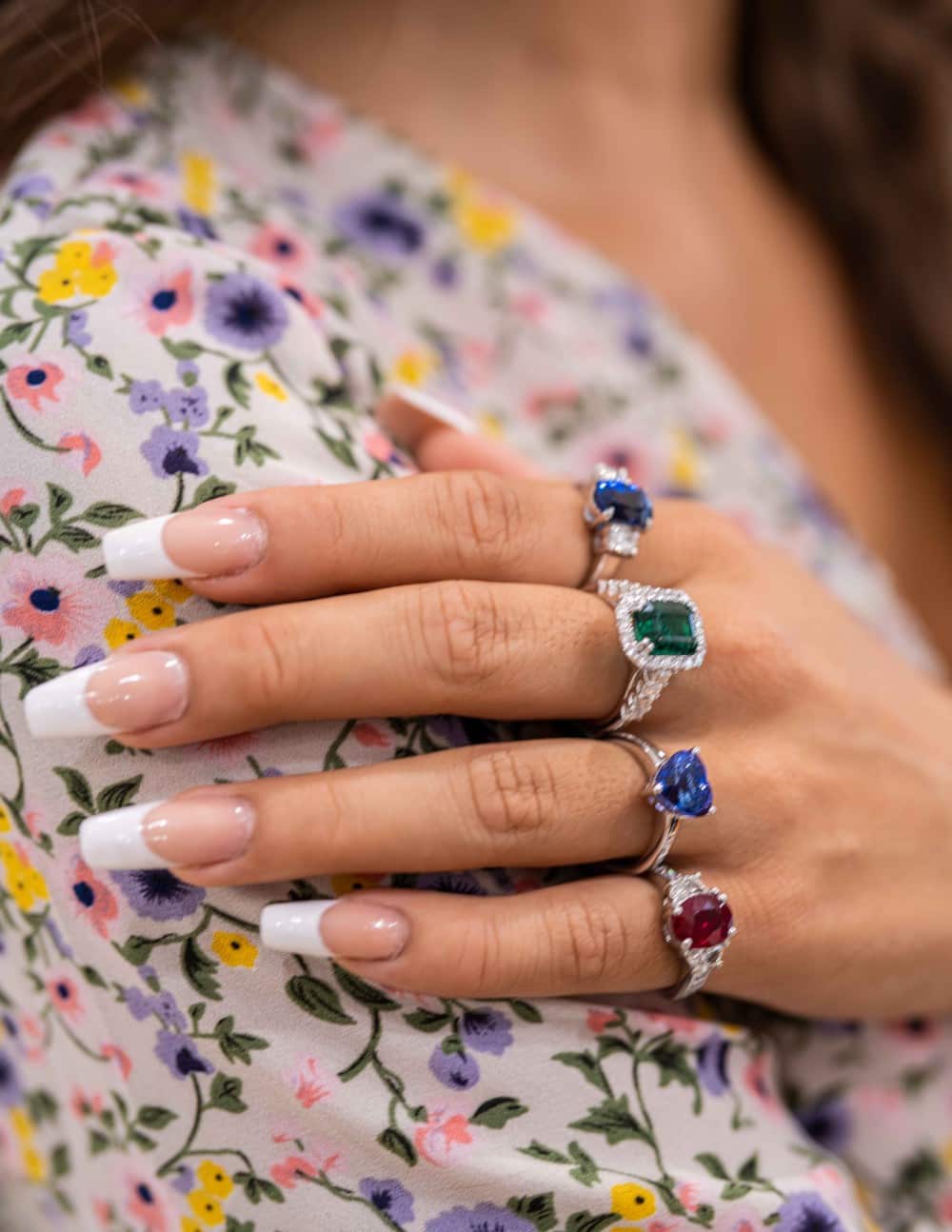Gemstone Guide
Beauty. Rarity. Durability. These attributes attract us to colored gemstones for personal adornment and make gemstones valuable and precious. Colored gemstones provide us the opportunity for uniquely personal expression.

Buying Colored Gemstone Jewelry
When buying colored gemstone jewelry, select what you consider beautiful. Because of the subtle differences in the tone and hue of the colored gemstone you are considering, look at several to find the one you prefer. At Caribbean Gems we also offer loose colored gemstones and are able to help you create a personalized mounting. You may prefer to buy a finished jewelry item. Discuss how you see yourself wearing the piece so that we can help you select mountings consistent with your lifestyle. This will provide the best safeguard for your purchase.
WHAT MAKES GEMSTONES SPECIAL?
Beauty - Most colored gemstones derive their beauty from their color. Purples, blues, greens, yellows, oranges, reds - we choose colored gemstones with beautiful color in mind. In certain colored gemstones color occurs naturally - satisfying hues are part and parcel of some garnets, for example. In other colored gemstones the final color occurs with assistance. For nearly as long as people have worn rubies, we have known how to treat a rough ruby with heat to obtain a desirable red color. Not all rubies are heat treated, but many are.
Gem cutters work to achieve a pleasing and affordable mix of color, weight (measured in carats) and a safe shape for mounting. During creation, a gemstone's size is constrained by nature. For example, while large and beautiful amethysts are readily available, an alexandrite of large size is extremely rare.
Sparkle adds to the beauty of a well-cut colored gemstone. The cut of a colored gemstone describes how it is shaped and whether it is formed well. Some gemstones, such as opal, are suited to a smooth, rounded surface. Others, such as sapphire, are more frequently shaped with a precise series of flat symmetrical planes, called facets, which make the most pleasing illumination of the gem's color. Some cutters today may also use convex or concave facets, shaping colored gemstone like small sculptures.
The clarity of colored gemstones contributes to their beauty. Unless a gemstone is opaque and blocks all light, how light moves through the gemstone affects it beauty. Some gemstones have no internal inclusions to interrupt the passage of light, as is the case with most pieces of tanzanite. Others tend to have characteristic inclusions, such as emerald, with a "jardine" (garden) which makes each emerald truly unique.
Rarity - Across time and cultures, people have adorned themselves with rare gem materials. From pearls and corals plucked from the seas, to bright colored pebbles found in the soils settling at the mouths of rivers; from the collection of gemstones mounted in the breastplate of Aaron as accounted in ancient scripture, to the historic gemstones mounted in the crown jewels of European monarchs, we let ourselves be known through the gemstones we choose to wear. These gemstones are precious because they are rare.
Because of their rarity, gemstones in which color is naturally occurring are generally the most valuable. Many gemstones are treated or enhanced in some way, such as with heat or safe irradiation, to achieve the beautiful colors or clarity we desire in the sizes we desire. These gems, which are less rare, are also valuable.
Durability- A gemstone's ability to be fashioned, mounted and worn is a function of how durable it is - a matter of both hardness and toughness. Some gemstones, such as sapphire, ruby and garnet, are well-suited to an active daily life and work well in rings, bracelets or cuff links. Others, such as emeralds, pearls and opals call for earring or necklace mountings to keep them beautifully displayed but out of harm's way.
Caring For Your Colored Gemstone Jewelry
As is true of all precious items, care extends the life of the jewelry and your pleasure in wearing it. A few pointers follow.
Daily Handling: Put on jewelry, especially cultured pearls, after you apply makeup, perfume or cologne.
Daily Wear: Remove jewelry before heavy yard work, home cleaning chores, working on heavy equipment or relaxing in a pool or spa (especially if you are in chlorine regularly).
Night Routine: After removing jewelry, wipe it gently with a soft cloth to remove residues of the day. Store items in a jewelry case or soft cloth so that they do not touch each other. This avoids the potential of harder gemstones scratching softer ones.
Insurance: Discuss your potential insurance needs with us or home insurance agent.
Specialized Cleaning: Discuss how to clean us with your jeweler. Avoid home cleaning solutions, including home ultrasonics, unless you are sure the item is suitable for home cleaning. Some jewelry is suited to home cleaning with a mild soap solution and a soft brush.
Cleaning: Have us clean your jewelry every time you visit the island. Allow 2-3 days for this.
Twelve-Month Security Check: If you visit the island yearly, ask your jeweler to check the security of your jewelry: are the prongs holding your gemstone secure, is the clasp secure, do the pearls need to be restrung, does the ring still fit securely or does it need to be resized? During this check your jeweler might also recommend a repolishing of the gemstone itself in order to restore the gem's original beauty.


